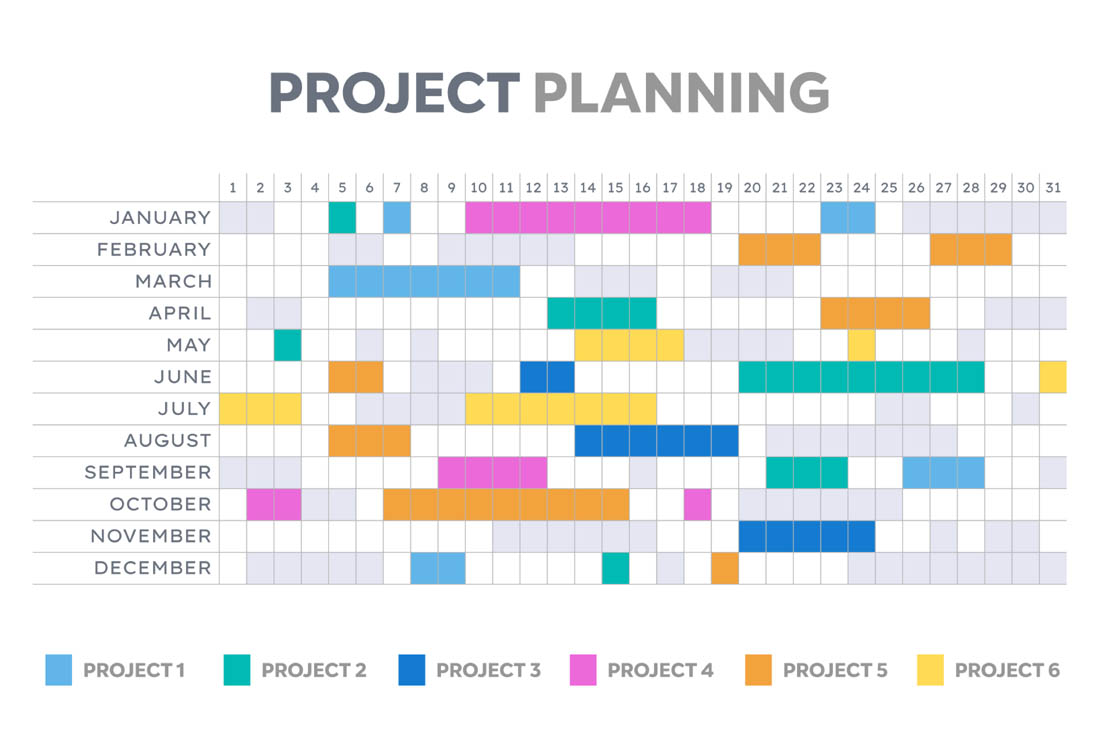Is your team continually behind schedule? Do you struggle to distribute workloads and meet deadlines? If so, don’t panic — this is the new reality for many managers. As budgets dwindle and teams are overextended, the problem may persist.
However, there is a way to get (and stay) ahead. It’s called project time management.
What is project time management?
Project time management is the process of planning, scheduling, and overseeing project activities to ensure work is completed on time and within budget. It involves setting clear milestones, tracking progress against timelines and proactively managing potential delays or roadblocks.
Successful project time management often includes breaking large initiatives into smaller tasks, estimating duration accurately, and adjusting timelines as needed to keep everything moving forward. It’s essential for meeting deadlines, maintaining momentum and ultimately achieving project goals.
- Estimate activity duration to set realistic expectations around the amount of time needed to complete each assigned task.
- Create a project timeline to clearly define the start and finish date for each activity.
- Monitor and adjust individual tasks, as needed, to resolve any issues and keep everyone on track.
Why is project time management important?
As work piles up and teams face competing deadlines, it’s hard to know what to prioritize. Without someone managing project timelines, your employees are free to decide which project activities take precedence — and what goes on the back burner. The result is missed deadlines and overlooked milestones, not to mention stress and anxiety as team members fall further behind.
This is why you need project time management — to keep everyone working toward the same shared goals. By monitoring and controlling priorities, you help create a harmonious workplace.
Project time management benefits
Effective task management doesn’t just lead to more productive employees. With the right strategies in place, you’ll also experience:
- Shorter deadlines: Proper time management makes it easier to complete tasks on time, ensuring customer satisfaction and helping you maintain a competitive edge in your market.
- Better use of resources: Managing project timelines also helps improve employee efficiency as you redistribute unbalanced workloads. By keeping your finger on the pulse of all activities, you’ll see if someone’s carrying more than their fair share of the burden.
- Controlled budgets: Time management helps control project costs by ensuring timely completion of activities and preventing delays that would otherwise lead to additional expenses.
- Improved communication: By adhering to project schedules, project managers have the details they need to update stakeholders and set clear expectations.
- Reduced Stress and Burnout: A well-structured project timeline with clear goals can alleviate the pressure on team members. When everyone knows what’s expected and when, it minimizes last-minute scrambles and overwork, leading to a healthier work environment.
- Enhanced Work-Life Balance: Effective project time management ensures tasks are completed within working hours, allowing team members to disconnect and recharge. This balance is crucial for maintaining long-term productivity and job satisfaction.
Project time management process: 6 easy steps
Remember, project time management is not the same as project management. The latter involves setting up workflows. The former ensures those workflows are completed in a timely manner. Follow these 6 six steps for effective project time management:
- Plan your project
- Define your deliverables
- Organize project tasks
- Create a timeline
- Assign jobs
- Schedule checkpoints
1. Plan your project
The first step is to build a project plan. Outline how you’ll structure, implement and monitor each aspect of the project as it progresses. This plan will provide visibility to everyone involved, from employees responsible for deliverables to the stakeholders you report to.
2. Define your deliverables
Next, create a list of all the assignments required to successfully complete your project. Start by identifying overarching activities before dividing each one into a subset of individual subtasks. This step helps ensure you don’t overlook important interdependencies or set unrealistic deadlines because you didn’t have the full picture.
3. Organize project tasks
Once you have a full list of activities, decide what order to complete them in. For example, should web design start after copywriting is finished? Or will the two activities occur simultaneously? When in doubt, ask. Your project team may have suggestions based on lessons learned from previous projects.
4. Create a timeline
As long as you know approximately how long each task and activity will take, you’re ready to create the project timeline. If you don’t know, go back to step three and ask employees for their input. Then use those activity duration estimates to arrange milestones and set deadlines in the appropriate order.
5. Assign jobs
Distributing tasks involves more than just deciding who will work on what. You also need to examine employees’ current workloads and decide how your project fits in with others already in progress. This will help you distribute workloads fairly and efficiently — if the same employee is responsible for multiple tasks, this will affect your timeline in step four.
6. Schedule checkpoints
Remember, effective project time management requires ongoing monitoring. Decide how you’ll communicate with team members on progress and address any roadblocks. If you use project management software, this may be as simple as setting up the right notifications and alerts. For more complex projects with a lot of players, consider scheduling a weekly or bi-weekly sync.
Tips for successful project time management
While there’s no one right way to manage project timelines, these best practices are a great place to start.
1. Seek input
Accurately estimating the time required for each project activity is crucial for effective time management. But you don’t have to work in a vacuum. Actively seek input from experienced project team members to understand how long each task will realistically take.
2. Leverage data
Has another team recently completed a similar project? Use the historical data from that project to inform your new set of tasks and timelines. This is especially valuable when it comes to estimating activity durations. You may discover that some tasks took less time than anticipated, while others required more.
3. Use the Pareto Principle
Also known as the 80/20 rule, the Pareto Principle states that 80% of your results come from 20% of your activities. Applied to project time management, this principle makes it easy to determine which activities will most directly impact progress. Use it as a guide when deciding where to focus efforts.
4. Prioritize
Another key aspect of project time management is prioritizing activities based on their importance and urgency. Try using the MoSCoW method to segment activities into groups of must haves, should haves, could haves and won’t haves. These categories help bring clarity to which tasks will require the most effort.
5. Redistribute as needed
Your project timelines don’t have to be set in stone. Whether you use project management software or create your own internal spreadsheets, choose an option that makes it easy to rearrange deadlines and assignments. This will allow you to stay agile when bottlenecks surface and adjustments are needed.
6. Use project planning tools
Finding the right scheduling and planning tools helps streamline project time management. For example, Gantt Charts provide graphical representations of project activities so you can visualize project schedules and dependencies. Or you might prefer basic project management software to house all your lists, calendars, charts and timelines in a central location.
7. Communicate regularly
If your team is continually behind schedule, you might need to provide more clarity. Open communication will help you see when someone is overwhelmed or you need to adjust expectations. Likewise, inform stakeholders of progress through regular updates to help prevent confusion or uncertainty.
8. Minimize distractions
A big part of keeping projects on schedule involves supporting team members. Offer to help employees structure their time, and minimize potential distractions so they can stay focused on tasks. Ensure employees have access to an environment where productivity can thrive and take other measures like eliminating unnecessary meetings.
9. Incorporate flexible “buffer” time
As a manager, it’s essential to account for the unexpected while supporting your team’s efficiency. Build flex or buffer time into project schedules, especially for critical tasks, to help employees navigate unforeseen challenges without feeling overwhelmed. This extra time can serve as a safety net, allowing employees to focus on quality and creativity rather than rushing to meet tight deadlines.
Best Project Time Management Tools
Not all tools for project time management are created equal. Some visualizations, charts, and interfaces are more effective at keeping teams on schedule. We recommend incorporating some of the following so everyone can keep track of their project time:
- Gantt Charts: Help visualize the schedule of tasks over time, including dependencies and sequencing. This enables managers to track actual progress vs. planned timelines and identify bottlenecks or delays to keep everyone on track.
- PERT Charts: Models tasks scheduling based on their estimated duration, using pessimistic, optimistic, and realistic estimates to manage uncertainty. This helps identify the “critical path,” or the sequence of tasks that directly impacts the project’s end date so team members are aware of when these key tasks need to be done.
- Project Timelines: These high-level views of major project milestones and deadlines offer a simple, easy-to-understand picture of progress. Once again, this emphasizes key dates, phases, and deliverables so everyone is aligned on what needs to be completed when.
- Kanban Boards: Visual task management method that organizes activities into “To Do,” “In Progress,” and “Done” columns, facilitating a smoother flow of work. These also make it easier to identify bottlenecks so managers can reallocate resources for support.
- Time Tracking/Timesheets: By recording the actual time spent on each task, it enables more accurate measurement of productivity, promotes accountability, and more. All of these benefits of timesheets (like those provided by ActivTrak’s solutions) help flag key areas for improvement, consistent under-allocation (or over-allocation) of resources and time to certain tasks, and more.
Take your project time management to the next level with ActivTrak
While there’s no magic spell for meeting deadlines and crushing goals, project time management gets you pretty close. If you want to make the process even easier, ActivTrak will help. Our workforce analytics platform empowers you with deep insights into how your employees work — and how they work best. Schedule a demo for a behind-the-scenes look at how we simplify project planning and help keep teams on track.





